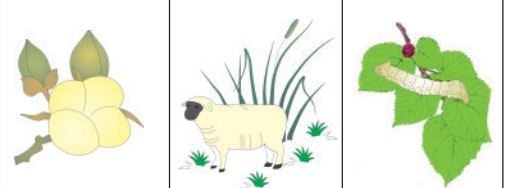7th Grade > Chemistry
FIBRE TO FABRIC MCQs
:
B
The rearing of silkworms for obtaining silk is called sericulture. Silkworms are reared under suitable conditions of temperature and humidity to obtain silk threads from their cocoons.
:
Keratin is the chief component of wool fibres.
:
Difference : 1 Mark
Definition: 1 Mark
All the fibres obtained from nature, i.e., plants or animals, are known as natural fibres. e.g. cotton, wool, linen, silk, etc
Cellulosic Fibres: Fibres obtained from plant sources are called cellulosic fibres.
Protein Fibres: Fibres that come from animal sources are known as protein fibres. e.g., wool and silk.
:
Differences: 1 Mark each
Linen: Fabric made from flax bast fibre is called linen. Linen fabric is shiny, smooth, durable and easy to wash. Like cotton, it wrinkles very easily, is cool, absorbent and is suitable for summer wear.
Jute: Like flax, jute is also a bast fibre. The fibres are short and lustrous but weaker than flax. The fibres are hairy and generally rough. It is used for making gunny bags and cords.
:
Each point: 1 Mark
Manmade fibre: Terylene, Acrylic
Natural fibre: Jute, Cotton
:
Entire cycle: 3 Marks
1) The female silk moth lays about 300 to 400 eggs at a time. The eggs hatch and the caterpillars or silkworms emerge. This is called the larval stage. The silkworm feeds on mulberry leaves.
2) It secretes fine filaments from two glands on its head. The filaments are made of a protein that hardens to form silk fibres when exposed to air. The silkworm deposits filaments in layers around its body, through figure-of-eight movements of the head, forming a structure called the cocoon. The silkworm takes three to seven days to prepare the cocoon, formed by about 20-39 concentric layers of a single thread.
3) Inside the cocoon, the silkworm enters the second stage of its life (called the pupa) and then the third and final stage to become an adult moth. Silk threads are obtained from the cocoon of the silkworm.![Click to Enlarge Image Explain The Life Cycle Of Silk Moth. [ 3 MARKS]](https://lakshyaeducation.in/quizpics/quiz/content_life-cycle-of-silkworm-2-638.jpg)
:
Explanation: 1 Mark each
a) Regenerated fibres: These fibres are made from extremely small cotton fibres or any other fibre source such as wood pulp, milk protein, etc. Chemicals are used to dissolve these and the solution is then converted into solid fibres. Examples are rayon, casein fibre (from milk) and soya bean fibre.
b) While obtaining silk from cocoon, firstly cocoons are boiled and then silk fibres are separated out, using machines. Machine unwinds the silk thread from cocoons. This process by which silk fibre is obtained is called reeling of silk.
:
Definition: 1 Mark each.
(i) Sericulture: The rearing of silkworms to obtain silk economically is called sericulture.
(ii) Scouring: The sheared skin with hair is thoroughly washed in tanks to remove grease, dust, and dirt. This is called scouring.
(iii) Rearing: It means taking care of herds of animals which includes feeding, grazing, breeding, etc. for economical purposes like meat and other useful products.
:
Each answer: 1 Mark
i) Silk is an animal fibre.
ii) Wool is the fibre that keeps our body warm.
iii) Angora goats are found in hilly regions like Jammu and Kashmir.
iv) China is the largest producer of silk.
v) Yarn is made up of fibres.

















